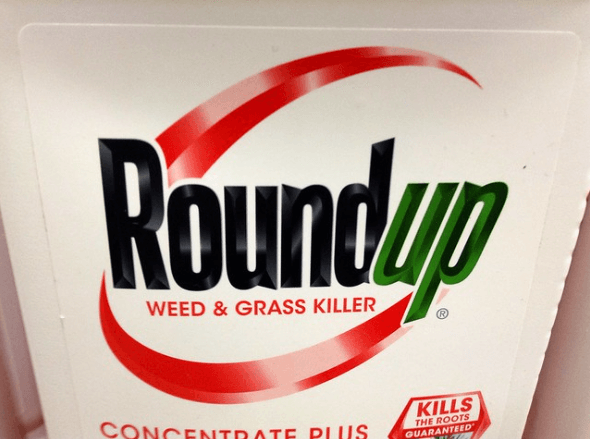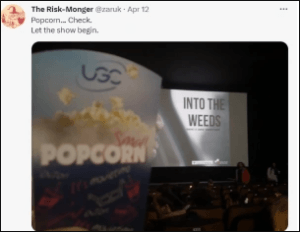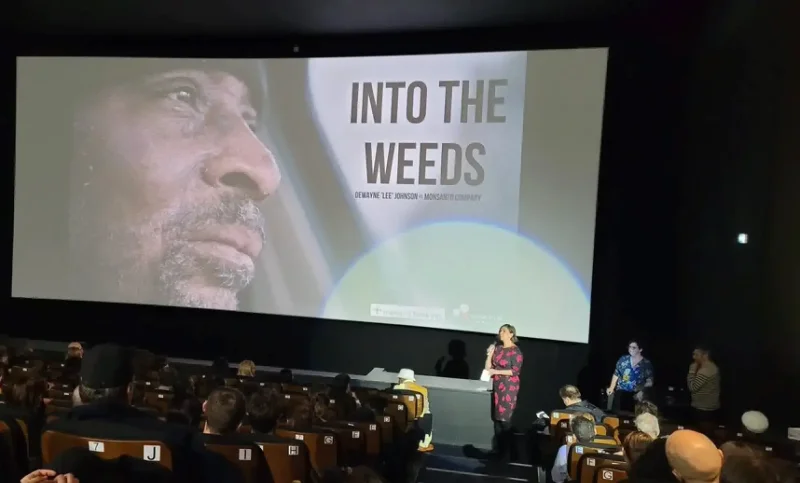In writing this review, I approached watching an activist documentary about how glyphosate kills everything not from the typical film-goer’s expectation (a need to be motivated, inspired and leaving with the satisfaction of a clear victory for good against evil), but as a gauge on how activists see the science, benefits and policies of this essential crop protection tool. It fit nicely into Section 4 of SlimeGate on Liars for Hire, as a demonstration of how activists are working on behalf of the US tort law industry.
A Predatort Lobbumentary
From the first scene post-intro, Into the Weeds highlighted the true heroes of the battle against Monsanto, the US tort lawyers, who used all of the screentime available to say how hard they worked, how they were constantly going into debt and how they were only doing this to seek justice for the little people who had suffered from those big corporations who don’t care and will never change if it were not for these martyrs. Into the Weeds was also about how Monsanto was ignoring the consequences of their poisons and how they tried to buy off scientists, writers and regulatory scientists.

Strangely, the film was not really about the protagonist, DeWayne “Lee” Johnson, who was the plaintiff in the first glyphosate case. About two-thirds of the film is presented from the eyes of the tort lawyers in what was film director, Jennifer Baichwal’s true “David and Goliath story”. The uncomfortable scenes with Johnson just served as emotional interludes to amplify the outrage.
At least seven tort lawyers were featured in the film (including two ruthless Scientologists). All of their comments or reflections were presented as heroic, virtuous and sacrificial. There was no serious talk of how much they take from any awards, how much the tort ecosystem siphons off or the outrageous gouging by the non-transparent litigation finance arms that allow these lawyers to fly around on private jets while the victims get next to nothing. The eighth lawyer in the film, who had the largest amount of screen time, was Timothy Litzenburg but his voice was not heard. This is understandable given that, soon after verdict, poor Tim was sold out and sent to prison for two years for trying to extort 200 million dollars from another company making an adjuvant found in Roundup.
Into the Weeds claims to be a documentary, but such a genre is meant to document facts. This film and the director, Jennifer Baichwal, presents a campaign to ban glyphosate and, from that, wove 90 minutes of emotional imagery into it. There was no balance or presentation of the issues from multiple perspectives. It sought merely to generate outrage while the film’s websites and social media accounts then try to enlist the viewers into multiple opportunities to take action. These film-related “impact screenings” and websites spread extremist views like how glyphosate causes birth defects or kills bees… but without providing solid evidence.
Into the Weeds needs to be reclassified as a “lobbumentary” rather than a documentary.
100% Fact Checked?
The Brussels “Impact Screening” of Into the Weeds started with an introduction from the director, Jennifer Baichwal. She wanted to let the audience know that we were about to witness is the truth (“It is not like some Michael Moore film where he just spouts off opinions that may or may not be true“). She made an effort to explain how, to comply with some litigation insurance, each point had to be rigorously fact checked and their lawyer went through each statement with a fine comb. This was reassuring especially in a film about Monsanto where we have been led to believe that nothing they say is true … ever.
But what about the omission of facts? Were those checked as well? Does it matter if you choose not to include certain facts that may influence the perception you want viewers to get? If Mrs Monger wants to know what I did during my weekend away and I only chose to tell her facts that make me look like a good, faithful husband, she may believe what I want her to believe, but if I withhold 90% of the facts, I hardly qualify for Husband of the Year. From that perspective, the film Into the Weeds has been unfaithful to reality (however carefully they have checked the little things they did choose to say).
Glyphosate, for example, is presented as a herbicide only used by farmers to make fields 100% weedless and as a desiccant that goes straight onto our table. If that is all we use it for, then very few farmers would worry about its removal from the market. The film chose to omit the ecological value of herbicides in no-till farming and in terminating complex, multi-species cover crops. These two applications allow farmers to farm much more sustainably, promote biodiversity and protect soil (something organic farmers cannot compete with). Omitting these facts is kind of not nothing so maybe the director should have had a better content adviser than that self-obsessed Carey Gillam.

Many of the clips where Monsanto employees were shown to contradict themselves had long pauses. These were conveniently cut by the film editor before they had a chance to finish their sentences or explain themselves. When Donna Farmer, for example, said that Monsanto could not confirm that Roundup was completely safe, what she in reality added was that they knew glyphosate was safe, but that they had not tested all of the other active ingredients. The director misleadingly and disingenuously cut the clip before she gave the full answer and only focused on one part of an email. Ironically, the tort law firms have been trying to play down the Farmer message since the evidence showing an adjuvant like POEA as being the main risk in Roundup would destroy their Glyphosate Gameplan and let Bayer off of the hook. So let’s just omit that fact.
When does omission of facts become lying? This is a common problem with dogmatic zealots. If they want to believe something is good, they happily bend reality to make it fit their ideology (like the completely unsustainable alternatives to glyphosate that PAN-Europe tried to promote in their recent dumpster-fire report). If they hate an organisation like Monsanto (or any industrial group), they will bend over backwards to present a negative perception. If zealots jam reality through their social-justice meat-grinder, they do not consider it as lying, but rather as fixing a terrible world. However they justify their falsehoods, please don’t call this 90-minute lobbying tirade a “documentary”. Jennifer Baichwal has only documented how narrow-minded and intolerant she is.
Into the Slime

One of the most stunning omissions of fact from Into the Weeds is how the film failed to document the extreme corruption, theft, secret funding, lies and injustices conducted day-in and day-out by the tort law industry. Baichwal worked tirelessly to portray these ruthless, cunning and greedy slimeballs as the heroes of her story. The first scene after the opening credits shows a convention of lawyers in Las Vegas talking about how tort lawyers are the only means to correct the dysfunctional American justice system. I wonder if Baichwal truly believes that these Predatorts are selfless martyrs who give up so much (money, time, opportunities…) in order to ensure justice for the little man is delivered against the evil corporation and the corrupt government.
Into the Weeds got ridiculous when they tried to sympathetically justify why tort lawyers are forced to take around 40% of the court settlements. 40%??? Try 80-90% and in cases of large-scale MDLs where companies settle out of court, more like 98% is poured back into the murky slime trough. The director chose to omit research into the entire ecosystem of bottom-feeders profiting from the plaintiffs: from the misery merchants trading people like commodities on the Predatort victim exchange to the ambulance chasers, ad and marketing consultants that blast the airwaves with compelling promises of big pay-outs.
For the last five years, SlimeGate has been patiently tracking the tort industry’s murky, non-transparent funding, use of off-shore accounts, litigation finance ponzi schemes, private jets and lavish parties with everyone on the take and with little left to give to the victims. Away from the cameras, tort lawyers regularly try to extort hundreds of millions from companies for themselves or funnel cash into slush funds to prop up corrupt politicians and judges in judicial hell-holes like Cook County or San Francisco’s district where the Johnson v Monsanto case took place. Maybe Jennifer Baichwal should have read SlimeGate rather than rely on the myopic view of her content adviser, that self-obsessed Carey Gillam. (Amusing side note: Carey Gillam, in her blogsite about Carey Gillam, announced that she sold the film rights to her books to Ms Baichwal. So stay tuned for an epic biopic about none other than Carey Gillam.)
In this tsunami of slime, greed and corruption, tort lawyers are regularly travelling to Brussels to lobby EU policymakers to help augment their caseload opportunities. They are funding NGOs to create public outrage against corporations (jury priming) and paying off scientists within the Ramazzini cabal to go to IARC to produce monographs they can then convert into ready-made cash machines. This corruption of science by an ethically-challenged, secretive interest group with billions in invisible money for targeted research funding, fear-mongering and disinformation is one of the biggest crises facing western justice systems (Predatorts are not fixing the problem, they ARE the problem).
Q: What do lawyers and sperm have in common?
A: Only one in 380 million have a chance of becoming a human being.
It was little surprise that at the Into the Weeds “Impact Screening” panel, we found a Ramazzini fellow, Daniele Mandrioli, asking for funds for his glyphosate study. He’ll soon be going back to Lyon to repay the favour during the IARC aspartame monograph working group, no doubt producing a hazard assessment tailored for the Predatorts linking aspartame to a variety of cancers. These lawyers will do quite nicely thanks to him. (Stock tip: Sell your shares in Coke before these vandals strike again.)
The post-film panel discussion focused on the need for independent science. Pray tell, Jennifer, with these Predatorts secretly funding billions to corrupted scientists to go to IARC to produce litigation-friendly results that will augment their caseload opportunities, how does this qualify as “independent science”. I suppose if you are a dogmatic zealot, then you will bend over backwards to justify anyone who is in a position to give it good to industry, but did you have to portray these Predatorts as heroic? Seriously?
Did Jennifer Baichwal understand this when she developed her storyline or did she just completely misplace her trust into the film’s self-obsessed content adviser, Carey Gillam? Another hero in the film is Gillam’s personal friend, Chris Portier, who had also travelled to Brussels for the entire week of festivities known as #StopGlyphosateWeek (I wish I were making this up). The film focused on his testimony with the plaintiff’s lawyer (but not when things unravelled for poor Chris under cross-examination). There was also an omission of fact when the film director chose not to highlight how Portier had to admit, under oath, that he was paid handsomely as a litigation consultant by law firms he had met just before going to IARC to sit on the glyphosate panel, that he did not disclose this Predatort funding for his political activism and that prior to the IARC panel, he had never worked on glyphosate research.
The film revealed a sad fact that DeWayne “Lee” Johnson has not yet received his 289 million USD (reduced on appeal and basically already pilfered away by his legal team). But this ran hollow with the irony that the film’s heroic scientist, Chris Portier, has already banked several million (and all he really had to do is show up and not tell anyone who was funding him). And Portier had the gall to stand beside Lee during the panel discussion in Brussels.
If these were facts that Jennifer Baichwal had to check, I could understand why she would want to conveniently omit them from her narrative. But don’t then call that the “truth”.
Then it got personal

Imagine the Risk-Monger leaving his dusty basement to travel to Brussels to watch an “Impact Screening” of a film about the evils of glyphosate. Sitting there, by himself, in a room with about 300 pesticide-hating activists, waiting for the lights to dim (popcorn finished), enduring the stares and disapproving whispers from those around him while quietly hoping that, unlike previous activist hate-fests he had attended, he would not be physically dragged out or spat on. Fortunately he only had to endure the PAN-Europe activist behind him repeatedly kicking his chair … that is … until the film started.
There was an unnecessarily long segment of the film about how Monsanto bought the world, paying off governments, scientists and media groups. The focus was juvenile and concentrated on that tired, overused email from a Monsanto director about ACSH. Their small donation was meaningless to the organisation’s total budget but those facts can be twisted to add to the drama. The screen then flashed articles with names of people who had written for ACSH, people whom the Into the Weeds self-obsessed content adviser, Carey Gillam, hated with a passion. Just one more payback attempt from this tragically spiteful individual who desperately needs to get over her belief that Monsanto, allegedly, got her fired from Reuters.
The film then shifted to a voiceover of Christopher Portier moaning that he didn’t know this person who had said such terrible things about him and wondered who was actually funding him. At the same time, four Risk-Monger articles were flashing across the screen. The Risk-Monger website even made the film’s credits at the end! Imagine that. So there was the Risk-Monger, out of popcorn, wondering why he was not invited to the film’s world premiere. All the Predatorts were there. Strangely, after seeing his articles on the big screen, the first thing to cross the Risk-Monger’s mind was how he had to improve his fonts and web layout.
It is clear Chris wanted this meaningless attack added into the film (and the film director had no second thoughts about the logic of focusing so much attention on some isolated little blogger living in a dusty basement in some small, backward little kingdom). Frankly, I don’t understand why the old boy is so bitter. He should be buying me a drink. Afterall, apparently I made him famous.
Chris suffers from a typical activist mindset where he believes that everyone is bought and paid for by someone with an interest. The main reason activists despise industry is not what they do, but that they can pay a higher price for someone’s integrity (that is, until the activists discovered they could make friends with tort sugar daddies). I suppose I must be the only person who did not receive any of those Monsanto millions (I didn’t even get one of those T-shirts FFS). Portier’s text carefully avoided directly declaring that the Risk-Monger was a Monsanto shill, but the suggestion, in the middle of a section on how Monsanto bought the world, deftly promoted that fiction.
The irony is that Chris Portier feels hurt. All I did was read his deposition (that his dear friend, Carey Gillam, had posted online) and comment on a few screenshots I had made on a free version of Macromedia Fireworks. The outrageous information was about what Chris had single-handedly done to his own character, IARC’s credibility and the reputation of science. And he wanted 35 seconds of film-time to judge me??? Does he not get how far he has destroyed the public trust in regulatory science (and all of that for a couple of million dollars)?
So the Risk-Monger wrote to the film’s director to notify her of the misinformation and personal slander. Jennifer Baichwal declined to answer. When she stood up in front of the audience before the film to declare how meticulously she had to fact check all of the information in the film, she was evidently lying through her teeth. Jennifer knows the suggestions that I was paid by Monsanto are false so she cleverly wordsmithed it (and she also knows what Chris Portier had to admit to under oath) but I suppose she doesn’t care. Where is her integrity here?
But it raised an interesting question: Who funded this dreadful tort lawyer film and all of the budgets for activists to travel around the world to promote it?
Into the Green
The funding of the production and promotion of Into the Weeds is curious. The film credits only state, in small letters flashed quickly in white, that the Utah Film Center is their “fiscal partner”. Not quite Hollywood but why Utah? Who is the Utah Film Center? And how much did they contribute to the film’s production and promotion?
Utah is unique in the film world since they offer generous tax incentives to finance films in the state. And the Utah Film Center, although a very small operation with minimal operating expenses, managed to raise 10 million USD in film funding during this film’s production year. That is because they offer the means for interested third parties to anonymously earmark funding (money restricted to certain projects). Some would call this a purification filter to hide unpleasant funding sources.
Since the Risk-Monger believes that transparency does not only apply to industry, he contacted the Utah Film Center. Their reply was that they had to “respect the privacy of the donors” but the kind woman assured me that there were multiple individuals and foundations that donated towards this film. So rather than seek and publish funding sources transparently, Into the Weeds employed a third party to act as fiscal partner and this organisation took a slice of the donors’ funds to wash out the after-taste and ensure anonymity. Hmm.
So let me get this straight because this goes right to the issue of the film director’s integrity. The Utah Film Center channelled an undisclosed amount of funds from undisclosed sources into Jennifer Baichwal’s production and promotion of Into the Weeds and nobody thought about looking more deeply into this?
Given that one of the main complaints against Monsanto is that the company secretly funded scientists, policymakers and media, it would be pure hypocrisy for the filmmaker to not transparently disclose her own funding sources and amounts received. So the Risk-Monger wrote to the film’s director to ask her this question. Jennifer Baichwal declined to answer. Hmm.

Since the film glorifies the tort lawyers as superheroes battling the great Satan, and since the tort law firms have stealthily paid off scientists, journalists and NGOs in the past, is it safe to assume that this film has received third party funding from such law firms? Did David secretly fund someone to make a film about how wonderful David was when he beat Goliath? Did this funding support the promotion of the film in Brussels during the activist-driven StopGlyphosateWeek?
This should not really be a big surprise. Everywhere the Carey and Chris Show goes, slime seems to follow.
This is all speculation since the director was not transparent, but the film’s credits did, for some reason, express gratitude to certain individuals, including Robert F. Kennedy Jr, a lawyer in the firm BaumHedlund (now WisnerBaum) that won the DeWayne “Lee” Johnson case. So did this rabid anti-vaxxer (and now presidential candidate) donate to the film? How many more Predatorts from WisnerBaum pitched in via this anonymous funding tool? (Scientologists can be quite generous when a campaign is in their interest.)
And this is the biggest problem with US tort law firms. No one is aware of the games they’re playing, the people they are paying off or the organisations they are supporting (unless it comes out in the court documents when they turn on each other). This is not attorney-client privilege. Rather, this is cunning, stealth lobbying by the tort law industry. Everyone else needs to be transparent, except them. Everyone else has to respect the scientific process (and not pay off scientists), except them. Everyone else needs to disclose their incomes and revenue sources, except them.
Nope! This film, and all of the costs of activists flying around the world to promote it, is paid by the Utah Film Center, and that is it. Go away stupid Monger and stop asking so many questions – we all know you’re an evil Monsanto shill.
Why is it that any whiff of industry funding can ruin careers but the tort industry funding, money based on lies and smoke and mirrors is OK? Why is it that NGOs can take money from everyone and their dog (anti-vax foundations, organic food industry lobbies, tort lawyers…) and no one raises a peep? I have drawn attention to this and I have paid heavily for it over the last eight years. This is hypocritical … if anyone in the non-profit movement would ever dare to be self-critical. Sadly they spend all of the energy and money criticising others.
The film, Into the Slime, delved deeply, and tragically, into the hypocrisy of the green activist movement. I heartily recommend watching it if you would like to witness a demonstration of how shallow and easily corruptible these liars for hire are.
David Zaruk is a Belgian-based environmental-health risk policy analyst specializing in the role of science in policy and societal issues. He blogs under the pseudonym: The Risk-Monger. Follow him on Twitter at @zaruk
A version of this article was originally posted at The Risk-Monger and has been reposted here with permission. Any reposting should credit the original author and provide links to both the GLP and the original article. Find The Risk-Monger on Twitter @zaruk































